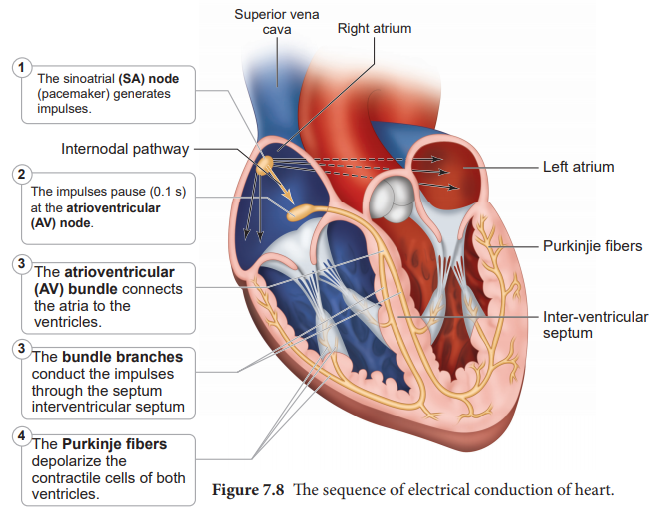The nurse is listening to the heart sounds of a client. The nurse recognizes that the S2:
Indicates the beginning of diastole
Coincides with the carotid artery pulse
is louder than an S1
Is caused by the closure of the semilunar valves
The Correct Answer is D
A. Indicates the beginning of diastole: This statement is not accurate. S2, the second heart sound, indicates the end of systole and the beginning of diastole. It is specifically associated with the closure of the aortic and pulmonary valves.
B. Coincides with the carotid artery pulse: This statement is not accurate. S2 is associated with the closure of the aortic and pulmonary valves in the heart, not with the carotid artery pulse.
C. Is louder than an S1: This statement is not accurate. S1, the first heart sound, is usually louder than S2. S1 is associated with the closure of the mitral and tricuspid valves and marks the beginning of systole.
D. Is caused by the closure of the semilunar valves: This statement is accurate. S2 is caused by the closure of the aortic and pulmonary valves, which are the semilunar valves in the heart. It marks the end of systole and the beginning of diastole.

Nursing Test Bank
Naxlex Comprehensive Predictor Exams
Related Questions
Correct Answer is B
Explanation
A. AV node - SA node - bundle of His - bundle branches:
This sequence is incorrect. The SA node (sinoatrial node) initiates the electrical impulse in the heart, followed by the AV node (atrioventricular node), bundle of His, and then the bundle branches.
B. SA node - AV node - bundle of His - bundle branches:
This sequence is correct. The electrical stimulus of the cardiac cycle starts at the SA node, which is the natural pacemaker of the heart. From the SA node, the impulse travels to the AV node, then to the bundle of His, and finally to the bundle branches, which distribute the impulse to the ventricles, causing them to contract.
C. Bundle of His - AV node - SA node - Erb's Point:
This sequence is incorrect. Erb's Point is a point on the chest where heart sounds S2 and S3 can be heard most distinctly.
D. AV node - SA node - bundle of His - Erb's Point:
This sequence is incorrect. The AV node comes after the SA node in the electrical conduction system of the heart. Erb's Point is not a part of the normal cardiac conduction pathway; it is a location for auscultation on the chest.
Correct Answer is A
Explanation
A. Wheezes:
Wheezes are continuous, high-pitched, whistling lung sounds that are heard especially during expiration and sometimes during inspiration. They are caused by the rapid movement of air through narrowed or constricted airways, which is common in conditions like asthma. Wheezing is a characteristic adventitious sound associated with asthma and other obstructive respiratory disorders.
B. Whispered Pectoriloquy:
Whispered Pectoriloquy is an increased loudness of whispering noted during auscultation with a stethoscope on the lung fields. This phenomenon occurs when sound is transmitted clearly through consolidated or compressed lung tissue, making whispered sounds more distinct. It is a sign of lung consolidation, often seen in conditions like pneumonia.
C. Bronchial Sounds:
Bronchial sounds are harsh, high-pitched sounds heard over the trachea and the large bronchi. These sounds are normally heard during expiration. If they are heard over peripheral lung areas, it can indicate consolidation or compression of lung tissue, possibly due to pneumonia or tumor.
D. Bronchophony:
Bronchophony is a phenomenon in which spoken sounds are heard more clearly and distinctly through the stethoscope on auscultation of the lungs. Normally, sounds are muffled during auscultation. Increased clarity of spoken sounds can indicate lung consolidation, similar to whispered pectoriloquy, and is often associated with conditions like pneumonia.
Whether you are a student looking to ace your exams or a practicing nurse seeking to enhance your expertise , our nursing education contents will empower you with the confidence and competence to make a difference in the lives of patients and become a respected leader in the healthcare field.
Visit Naxlex, invest in your future and unlock endless possibilities with our unparalleled nursing education contents today
Report Wrong Answer on the Current Question
Do you disagree with the answer? If yes, what is your expected answer? Explain.
Kindly be descriptive with the issue you are facing.
